Reserve Bank of Australia Annual Report – 1984 Financial Intermediation
Financing
Financing patterns in 1983/84 were dominated, as they were the previous year, by substantial demands for finance by the public sector. The Commonwealth Government greatly increased its borrowing requirement and local and semi-government authorities were again active in seeking funds. Offsetting factors meant that these demands did not put financial markets under strong pressure. One was the decline in borrowing by the corporate sector because of the weakness of investment spending, a revival of corporate profits and lower tax payments. Another was the increase in lending by households as their savings grew strongly. There was also a slight increase in net lending by the rest of the world. In this environment, the public sector was able to finance a much larger deficit in 1983/84 at nominal interest rates which were a little lower on average than in 1982/83. The average, nevertheless, masked an uneven trend in interest rates over the year, as discussed in the previous chapter.
The Commonwealth's budget deficit in 1983/84 was $7,961 million, or about 4¼ per cent of gross domestic product (GDP). This was below the estimate of $8,361 million in the Budget Speech, but much larger than the deficit of $4,473 million in 1982/83 (2.7 per cent of GDP). The manner in which the deficit was financed is illustrated in Graph 4. Net borrowing abroad was $362 million. Bonds comprised by far the largest proportion of domestic financing, with groups other than financial intermediaries taking up a record amount. Australian Savings Bonds (ASBs) also proved attractive although net subscriptions were below the figure for 1982/83.
Borrowings by local and semi-government authorities in 1983/84 continued at the very high level of the previous year. Borrowings amounted to $6,791 million, including $775 million raised abroad. In 1982/83, borrowings totalled $5,830 million.
The total borrowing requirement of the public sector in 1983/84 was about $15½ billion. This was equivalent to 8¼ per cent of GDP, around 1½ percentage points higher than in the previous year and over 4 percentage points higher than two years earlier. The large public sector deficits in the last two years have meant that the ratio of public debt to GDP, which had declined for most of the post-war period, has risen sharply – from 33 per cent in June 1982 to about 41 per cent in June 1984. Interest payments on this debt were just under 12 per cent of total public sector outlays in 1983/84. Longer-run trends in public sector financing are shown in Graph 11 (on page 36).
| Announced | Currency | Net proceeds |
|---|---|---|
| ($Am) | ||
| 19 July 1983 | United States dollars | 448 |
| 4 October | United States dollars | 533 |
| 17 October | Sterling | 145 |
| 6 March 1984 | Swiss francs | 30 |
4 Financing the Commonwealth Budget Deficit
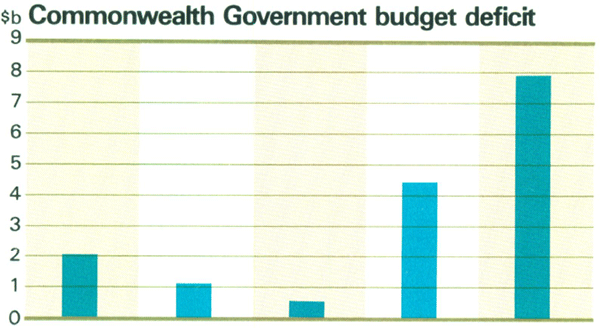

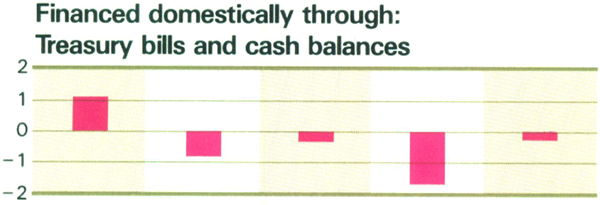
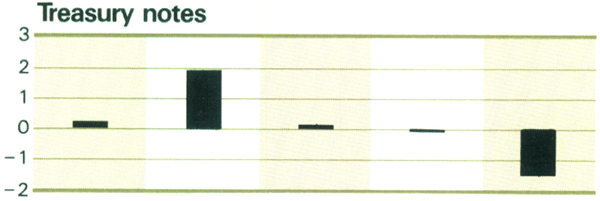

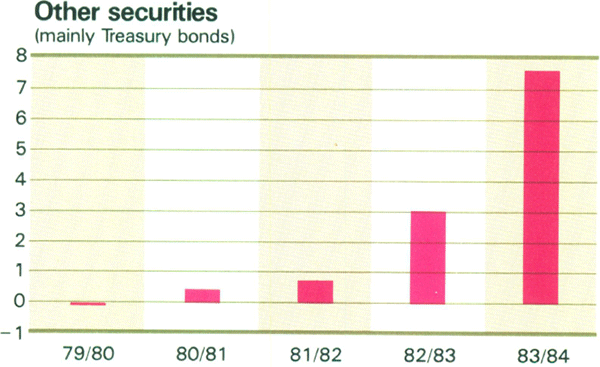


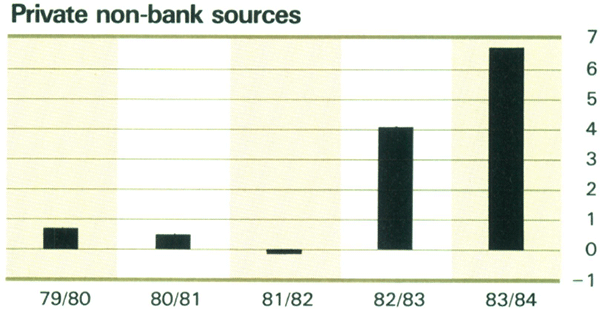
| 1980 | 1981 | 1982 | 1983 | 1984 | |
|---|---|---|---|---|---|
| Deposits with banks (of which: savings banks) |
12.4 (7.2) |
12.7 (9.3) |
11.2 (7.7) |
12.9 (19.2) |
10.4 (15.2) |
| Borrowings by non-bank financial institutions (b) | 18.5 | 18.8 | 18.2 | 10.0 | 12.3(e) |
| Borrowings by all financial institutions (c) | 14.1 | 15.9 | 14.0 | 10.9 | 113(e) |
| Advances outstanding of all financial institutions | 16.2 | 17.6 | 16.0 | 10.2 | 12.2(e) |
| (a) Adjusted for breaks in series (b) Corporations, with assets over $5 million, registered under the Financial Corporations Act (c) Banks plus corporations under (b) (e) Estimate |
|||||
The public sector's recourse to finance directly from the public rather than through intermediaries was one reason why – despite the large Commonwealth deficit – the balance sheets of financial intermediaries grew only a little faster in 1983/84 than in the previous year. The sluggishness in business demand for credit was an additional factor. Borrowing and lending by financial intermediaries as a whole remained subdued for some time but growth rates quickened from around the end of 1983. The table above summarises these growth rates. The details for the various groups are given in the following section.
A strong revival in the share market over much of 1983/84 had an important bearing on other forms of private financing. As confidence about the economic recovery increased, the “all ordinaries” index rose from 605 at end June 1983 to a peak of 788 in January 1984; after dropping sharply in May, it finished the year at 659. New equity issues were well above their relatively low levels of the previous year. Issues of, and trading in, corporate debentures on the other hand remained subdued.
Intermediaries
The uneven character of the economic recovery had a key bearing on the performance of the different groups of financial intermediaries during 1983/84. For much of the year, groups dealing mainly with the corporate sector saw only sluggish growth in their balance sheets; intermediaries catering for the household sector performed more strongly. In this sense, the pattern of intermediation repeated that of the previous year when economic activity was contracting. Despite the rebound in activity, the overall pace of intermediation during 1983/84 was – for reasons given above – only slightly quicker. Banks grew a good deal faster than non-banks in the first half of 1983/84. In the second half, however, growth of non-banks – particularly money market corporations – accelerated quite sharply and by year end non-banks were growing at much the same pace as banks. In the year to the June quarter, borrowings by all financial intermediaries grew by about 11.5 per cent, compared with 11.2 per cent in 1982/83. Growth in M3 was 11.4 per cent (on the same basis), a little below its rate in the previous year. Disturbances to financial markets around the time the Australian dollar was floated tended to blur trends in financial aggregates for some months[*].
Within financial markets, competition remained vigorous over the year. One sign was the sensitivity of market participants to interest rate relativities. This was reflected, for example, in the choice of financial instruments. Borrowers increasingly sought optional drawing facilities – overdraft, bill financing and overseas credit lines – permitting them to switch from one to the other as relative costs changed. Competition among lenders also led banks to lower their commitment fees, which encouraged borrowers to take on overdraft and bill facilities, often split between banks. With bill yields lower on average than overdraft rates, bill financing grew much more strongly than overdrafts in 1983/84. Interest differentials were also a crucial factor in market responses to the substantial build-up of liquidity prior to the float. In pursuit of interest-earning outlets, funds moved strongly into those intermediaries, particularly the household savings institutions, which did not quickly adjust interest rates. Net subscriptions to ASBs were also boosted considerably. Other intermediaries took advantage of the conditions to reduce yields offered on their liabilities; as a result, interest rates on short-term money market investments generally fell sharply. The changing relativities provided strong incentives for lenders and borrowers to rearrange their short-term portfolios.
Another important illustration of the strongly competitive climate in financial markets was the performance of savings banks. These ran well ahead of other major groups and were mainly responsible for an increased share of intermediation by banks over much of the year. There were several reasons why savings banks attracted such a large share of deposits. As already noted, cyclical factors – particularly the high level of household savings in 1983/84 – tended to favour the growth of household savings institutions. The earlier easing of regulations combined with the popularity of automatic telling machines allowed savings banks to market attractive deposit packages. In addition, savings banks delayed following downward adjustments to interest rates. The sizeable deposit inflow was used to meet strong demand for housing finance, with the balance largely reflecting in increased holdings of liquid assets surplus to formal requirements. As a consequence, savings banks played a much larger part than hitherto in financing – both directly and indirectly – the June quarter seasonal rundown. This role was also influenced by the more integrated management of trading and savings banks by national banking groups. During the year, the Government announced a further easing of regulations on trading and savings banks, which were to take effect from 1 August 1984. (See below).
The experiences of the major groups of financial intermediaries in 1983/84 are outlined briefly in the following paragraphs.
Changes to Bank Deposit Arrangements
On 10 April, the Reserve Bank announced the withdrawal of the following controls on bank deposits:
- the minimum term of 30 days for fixed deposits of less than $50,000 offered by trading banks and savings banks;
- the maximum size (less than $50,000) of fixed deposits offered by savings banks;
- the minimum term of 14 days for fixed deposits and certificates of deposit of $50,000 and over issued by trading banks;
- the maximum term of 48 months for interest bearing deposits of trading banks and fixed deposits of savings banks.
At the same time, the Government announced its decision to amend the Banking (Savings Bank) Regulations so as to:
- allow savings banks to offer cheque facilities on all accounts;
- remove the $100,000 limit on deposits by a trading or profit-making body.
Both sets of changes were to take effect from 1 August 1984.
Trading bank activity was relatively subdued in the early months but began to expand thereafter. Deposits increased by just over 6 per cent during the year, somewhat less than in 1982/83 and well below rates in previous years. The slower growth of term deposits (including certificates of deposit) within the total reflected the limited need to fund lending and the enhanced competitive position of savings banks. Loans, advances and bills discounted rose by around 11 per cent, mainly to meet working capital needs and stronger household sector demand. Holdings of bills discounted increased sharply towards the end of 1983 as banks sought to invest the substantial increase in deposits arising from the inflow of funds from offshore and, apparently, to build up liquid assets for the seasonal rundown. This involved some shifting of financing from non-financial enterprises. Over the next three months these holdings were substantially reduced. Overdrafts grew very slowly for most of the year but rose sharply during the seasonal rundown; for a time, the change in the pattern of seasonal financing from overseas to domestic credit sources made it difficult to judge the underlying demand for credit.
Cost differentials favouring bill financing were reflected in a very strong increase in bill limits of trading banks in 1983/84. In recent years, the acceptance of bills has been the fastest growing area of trading banks' operations. The value of bank bills outstanding grew by 30 per cent in 1983/84; over the past five years the annual rate of growth averaged 35 per cent.
Trading banks reduced their interest rates significantly in the first half of 1983/84, notwithstanding signs of stronger demand for advances. These declines were reversed in the following months when the cost of funds to the market rose strongly. As these costs eased after mid May, rates again edged downwards.
National banking groups kept comfortable levels of liquidity over the year, mainly on the books of their savings banks. Except in the month of December, major trading banks held only slim margins of liquidity above the 18 per cent LGS convention and negligible balances with the official short term money market. However, their associated savings banks were in a strong position to provide them with liquidity assistance. During the seasonal rundown, savings banks transferred to trading banks around $1 billion of LGS assets in exchange for other assets, including personal instalment loans and farm development loans. Nonetheless, trading banks also found it necessary at times to bid for funds in the market. The SRD ratio was unchanged at 7 per cent throughout the year.
5 Indicators of Financial Conditions
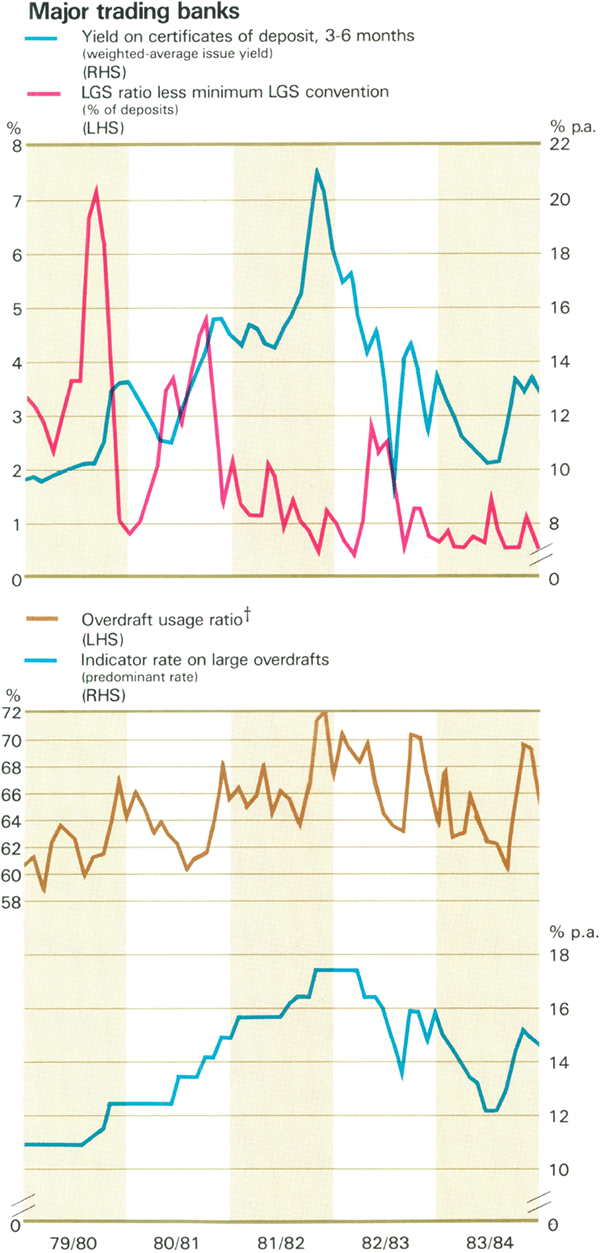
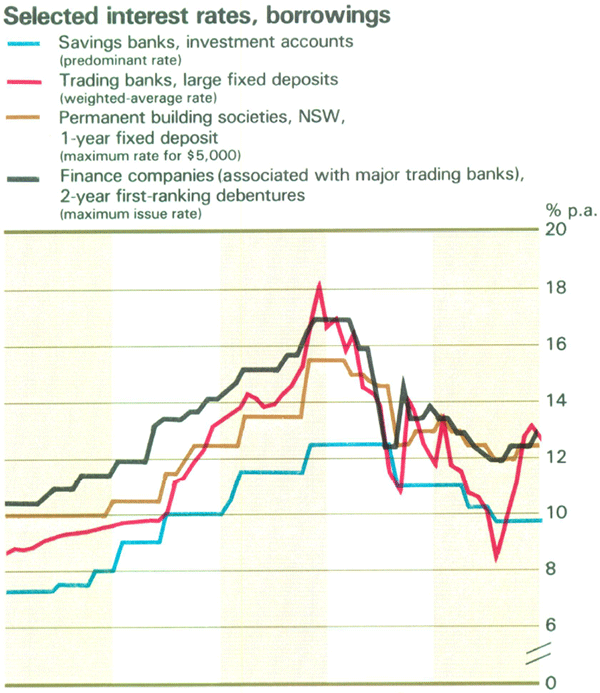
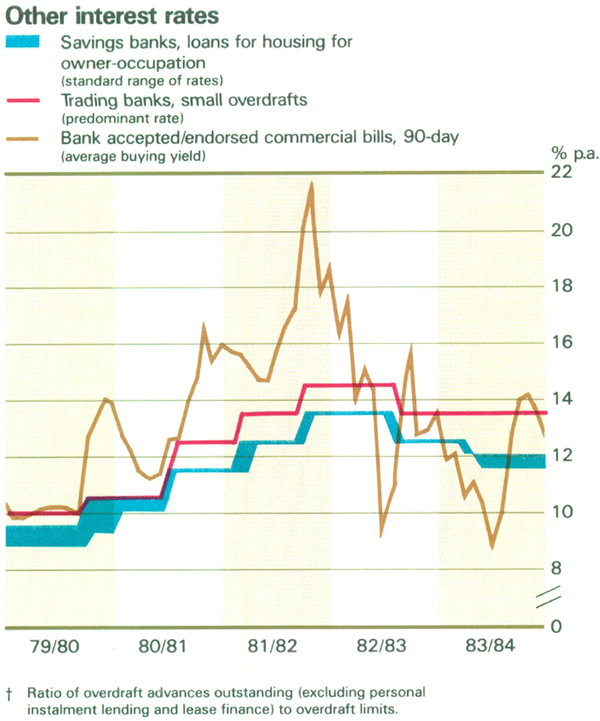
Although their growth peaked early in the year, savings banks remained the pace-setters. Their deposits increased by about 15 per cent, less than in the previous year but still well above earlier growth. Inflows were sustained until March despite reductions in deposit rates of interest and strong competition from ASBs, an alternative outlet for household savings. Some reasons for this were given above. Deposits fell in March and April, much more sharply than in previous years, as funds were withdrawn to make provisional tax payments. Outflows continued after the seasonal rundown was negotiated, reflecting a loss of competitiveness of savings bank deposit facilities.
The strong deposit growth meant that savings banks were well-placed to meet the surge in demand for housing finance over the year. Underlying this surge were falls in housing loan interest rates since early 1983, growing consumer confidence and the Government's First Home Owners' Assistance Scheme from 1 October 1983. Savings banks' approvals of loans for housing reached $4.9 billion in 1983/84. This was 40 per cent above the record level of approvals the year earlier, and accorded with assurances given to the Government by banks (and building societies) that they would be able to increase their lending for housing significantly in 1983/84. Advances for housing grew by around 14 per cent over the year, a percentage point higher than in 1982/83. One reason for the disparity between rates of growth of approvals and advances was the strongly rising trend in the level of repayments of existing loans.
Savings banks were very liquid for most of the year. Up to March, holdings of LGS assets averaged 20 per cent of deposits, but they fell to a little below 18 per cent by year end following the outflow of deposits and the transfer of LGS assets to trading bank partners to help meet their liquidity needs. The required minimum ratio for banks subject to the Banking Act is 15 per cent.
Permanent building societies also benefited from the strength of demand for housing finance. In 1983/84, their borrowings increased by 15 per cent, the strongest performance in four years. Loan approvals for housing came to over $3¼ billion, a record figure. Growth in housing loans outstanding was almost 13 per cent, somewhat lower than growth in borrowings. As a consequence, societies held much higher levels of liquid assets, mainly in the form of public sector securities and bills.
Intermediation by finance companies was very subdued. Faced with weak loan demand, finance companies did not actively seek funds; their debenture interest rates fell sharply in the first half of the year and were slow to respond to the subsequent increase in the general level of interest rates. Borrowings from the public increased by only about 3 per cent, compared with a rise of about 4 per cent in 1982/83. Lending activity – in all categories – was dormant until the last months of the year when it showed signs of rising strongly.
The activity of money market corporations fluctuated – at times sharply – during the year. Overall, borrowings from the public increased by about 18 per cent, somewhat above growth in 1982/83 but well below rates in previous years. Lending grew by about 17 per cent, mostly in holdings of commercial bills. There were two particular episodes when balance sheets expanded strongly. One was prior to the float, when money market corporations substantially increased their borrowings from non-residents. These borrowings were mostly invested in short-term liquidity placements and were partially repaid over the following two months. The second episode was in March, when money market corporations sharply increased borrowings from the public in order to purchase bills from banks. These purchases appear to have been made largely in the expectation – which did not materialise – of an early fall in short-term interest rates. Bill holdings were run off substantially in the following months.
The interest rate incentives which encouraged the early rapid growth of cash management trusts disappeared over much of 1983/84, as yields on commercial bills – the trusts' main assets – fell below those on deposits with intermediaries and on ASBs. Their total assets fell steadily up to April, but then stabilized when rising bill rates restored some of the relative attractiveness of the trusts. At year end, trusts held assets of about $1,470 million, compared with assets of about $2,200 million in June 1983; the number of trusts remained unchanged at 16.
Other developments
During the year the Government announced a re-organisation of the Commonwealth Banking Corporation. This involved amendment of the Commonwealth Banks Act to make the Commonwealth Savings Bank a wholly-owned subsidiary of the Commonwealth Trading Bank (they were previously separate statutory bodies) and to change the name of the latter bank to the Commonwealth Bank of Australia with effect from 29 June 1984. Measures were taken to bolster the capital position of that bank, additional to a capital injection provided from the 1983/84 Budget. All members of the Commonwealth Banking Group, including the Commonwealth Development Bank, will be subject to company income tax.
The Government also stated it is considering a private sector proposal for the establishment of a new, predominantly Australian-owned trading bank (the “Macquarie Bank Limited”) within existing policy on participation in banking. The Government indicated that the proposal appeared consistent with this policy, and was capable of being developed to a point where the Government could recommend granting of a banking authority.
In June 1984, Australia and New Zealand Banking Group Limited (ANZ) announced a proposal to acquire the whole of the issued capital of Grindlays Holdings PLC whose principal subsidiary is Grindlays Bank, an international bank incorporated in the United Kingdom. The ANZ said that, while the consideration for the acquisition of Grindlays Holdings PLC would be provided out of the resources already available, it believed that it was appropriate to raise further capital from shareholders at that time to maintain prudent capital ratios. The ANZ announced a one-for-four rights issue. The Reserve Bank was consulted throughout the discussions leading up to the proposal to acquire Grindlays Holdings PLC and raised no objection to the offer.
6 FINANCIAL INSTITUTIONS: BORROWINGS AND ADVANCES OUTSTANDING
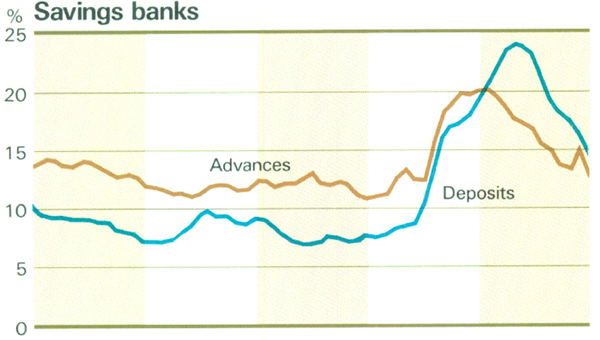
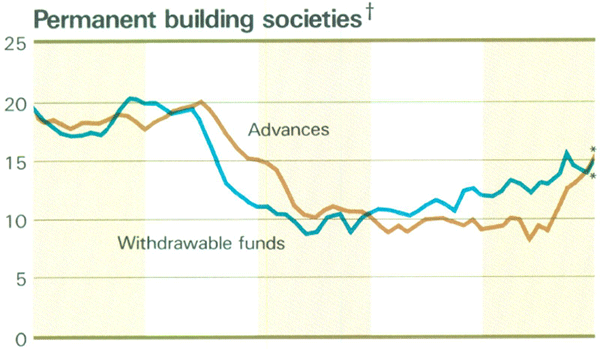
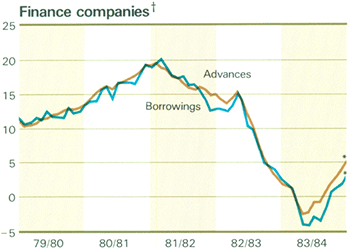
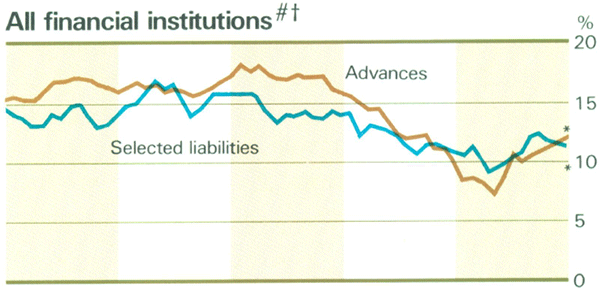
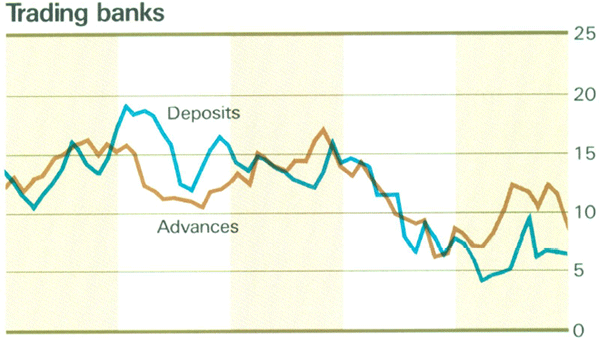
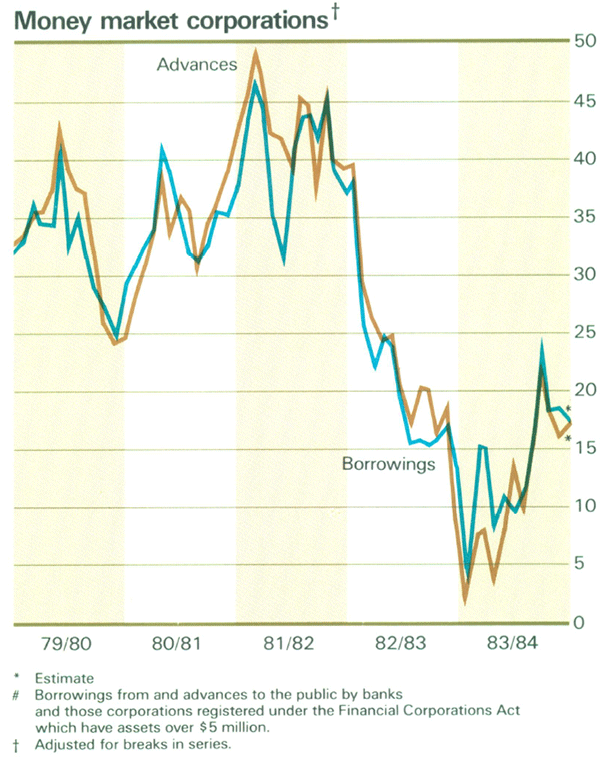
A new savings bank, Bank of Queensland Savings Bank Ltd, commenced operations in September 1983. The merger of The Savings Bank of South Australia and The State Bank of South Australia (both state-owned institutions) came into effect in July 1984.
Through mergers or amalgamations, the number of building societies (with assets in excess of $1 million) fell from 80 to 76, a much smaller decline than in the two previous years. A merger of finance companies affiliated with two major trading banks was completed, after the merger of their trading bank parents in 1982/83. The establishment of eight new money market corporations continued the growth in this area over recent years. During the year the operations of three cash management trusts were merged, and the management of another two was combined. Two new trusts began operations. Eleven foreign banks were granted permission to open representative offices in Australia, raising the total to 105 offices.
Supervision of banks
The general philosophy underlying the Bank's approach to the supervision of banks has been discussed in previous years' Reports (for example, pages 27–28 of the 1982/83 Report). To this point, the effectiveness of supervision has owed something to the relatively small number of banks operating in Australia and their willingness to consult with, and accept advice from, the Bank. Developments in the period ahead, however, may call for a shift towards greater formality in supervision. Australian banks are rapidly diversifying their activities at home and abroad as part of the processes of financial innovation and integration. Also, an increase in the number of banks operating in Australia may make it difficult to continue a system which relies on informal consultation. Against this background, there may be a need to have more formal supervisory powers incorporated in the banking legislation. However, in the changing Australian financial scene, the approach to supervision will need to remain flexible and adaptable; in particular it would not be desirable for a statutory framework to be substituted for a sense of prudential responsibility by the banks themselves.
The Bank attaches great importance to ensuring that the capital resources of individual banks are adequate to the size, quality and spread of their business, and has counselled banks that they should avoid any weakening of their capital ratios. The downward trend in capital ratios over the previous couple of years appears generally to have abated, although comparisons have been complicated by the effects of recent bank mergers. Discussions with banks are continuing.
The Bank is seeking to establish a framework for the prudential supervision of trading banks' liquidity. Aspects being examined include the liquidity implications of banks' foreign currency business, which has increased in importance since foreign exchange arrangements were changed in December.
Following these changes in foreign exchange arrangements, the Bank took steps to ensure that it was adequately informed about banks' internal control systems and management limits on various risks in their foreign exchange operations, including currency exposure and maturity mismatching. The details sought were on both a global and an individual centre basis. During the year, the Bank also discussed with banks the importance of large commitments in their lending portfolios.
International operations of Australian banks have continued to grow more quickly than domestic operations. Banks have been asked to ensure that the development of international operations does not out-run their managerial and capital resources. The Bank also reiterated its wish to be consulted on major developments in this area, including establishment of new branches and subsidiaries overseas, reorganisation of existing operations and overseas fund raisings. In addition, the Bank has taken steps to improve the range and flow of information it receives on banks' international operations. Australian banks' loans outstanding to countries experiencing debt servicing problems remain relatively modest.
The Bank also confirmed its unwillingness to agree to Australian banks providing “letters of comfort” to overseas supervisory authorities in support of banks' foreign operations. The Bank has a responsibility to ensure that any assurances or undertakings in respect of banks' overseas operations are without prejudice to the depositor protection provisions of the Banking Act. Insofar as a bank wishes to provide support for an overseas associate, in the opinion of the Bank it should do so primarily by ensuring that its associate is prudently managed and has under its own control capital resources fully adequate to the scale and nature of its operations.
In light of the Government's decision on bank deposit controls, the Bank reviewed its long-standing requirement that banks limit to 60 per cent their holdings of equity capital in merchant banks. That requirement took account of the scope for official restraints on banks to be avoided by shifting conventional banking business to those affiliates. In August 1984, the Bank withdrew the restraint on equity investment by banks in merchant banks. However, the Bank would not wish a bank subsidiary to become large relative to the bank itself.
Footnote
This episode is detailed in the half-yearly review of financial intermediation in the March 1984 issue of the Bank's Bulletin. [*]